公司的核心竞争力【外文翻译】
- 格式:doc
- 大小:58.00 KB
- 文档页数:14
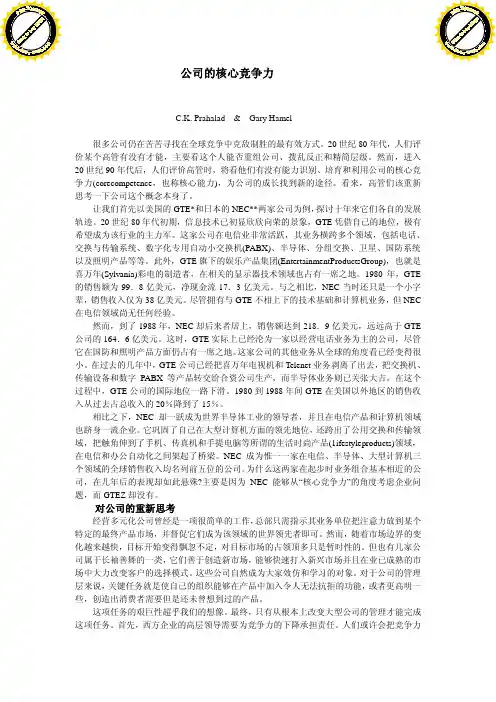
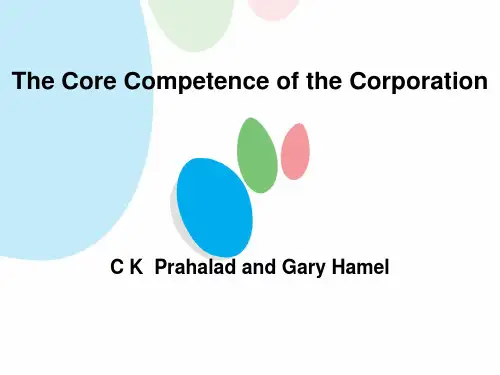
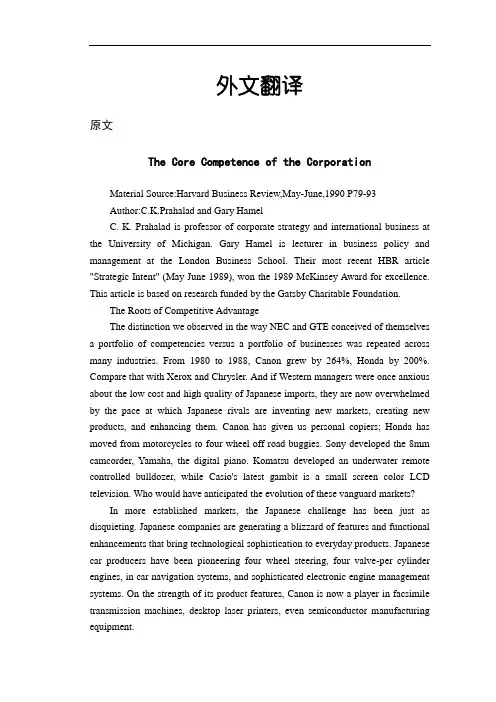
外文翻译原文The Core Competence of the CorporationMaterial Source:Harvard Business Review,May-June,1990 P79-93Author:C.K.Prahalad and Gary HamelC. K. Prahalad is professor of corporate strategy and international business at the University of Michigan. Gary Hamel is lecturer in business policy and management at the London Business School. Their most recent HBR article "Strategic Intent" (May June 1989), won the 1989 McKinsey Award for excellence. This article is based on research funded by the Gatsby Charitable Foundation.The Roots of Competitive AdvantageThe distinction we observed in the way NEC and GTE conceived of themselves a portfolio of competencies versus a portfolio of businesses was repeated across many industries. From 1980 to 1988, Canon grew by 264%, Honda by 200%. Compare that with Xerox and Chrysler. And if Western managers were once anxious about the low cost and high quality of Japanese imports, they are now overwhelmed by the pace at which Japanese rivals are inventing new markets, creating new products, and enhancing them. Canon has given us personal copiers; Honda has moved from motorcycles to four wheel off road buggies. Sony developed the 8mm camcorder, Yamaha, the digital piano. Komatsu developed an underwater remote controlled bulldozer, while Casio's latest gambit is a small screen color LCD television. Who would have anticipated the evolution of these vanguard markets?In more established markets, the Japanese challenge has been just as disquieting. Japanese companies are generating a blizzard of features and functional enhancements that bring technological sophistication to everyday products. Japanese car producers have been pioneering four wheel steering, four valve-per cylinder engines, in car navigation systems, and sophisticated electronic engine management systems. On the strength of its product features, Canon is now a player in facsimile transmission machines, desktop laser printers, even semiconductor manufacturing equipment.In the short run, a company's competitiveness derives from the price/performance attributes of current products. But the survivors of the first wave of global competition, Western and Japanese alike, are all converging on similar and formidable standards for product cost and quality minimum hurdles for continued competition, but less and less important as sources of differential advantage. In the long run, competitiveness derives from an ability to build, at lower cost and more speedily than competitors, the core competencies that spawn unanticipated products. The real sources of advantage are to be found in management's ability to consolidate corporatewide technologies and production skills into competencies that empower individual businesses to adapt quickly to changing opportunities.Senior executives who claim that they cannot build core competencies either because they feel the autonomy of business units is sacrosanct or because their feet are held to the quarterly budget fire should think again. The problem in many Western companies is not that their senior executives are any less capable than those in Japan nor that Japanese companies possess greater technical capabilities. Instead, it is their adherence to a concept of the corporation that unnecessarily limits the ability of individual businesses to fully exploit the deep reservoir of technological capability that many American and European companies possess.The diversified corporation is a large tree. The trunk and major limbs are core products, the smaller branches are business units; the leaves, flowers, and fruit are end products. The root system that provides nourishment, sustenance, and stability is the core competence. You can miss the strength of competitors by looking only at their end products, in the same way you miss the strength of a tree if you look only at its leaves. (See the chart "Competencies: The Roots of Competitiveness.”) Core competencies are the collective learning in the organization, especially how to coordinate diverse production skills and integrate multiple streams of technologies. Consider Sony's capacity to miniaturize or Philips's optical media expertise. The theoretical knowledge to put a radio on a chip does not in itself assure a company the skill to produce a miniature radio no bigger than a business card. To bring off this feat, Casio must harmonize know how in miniaturization, microprocessor design, material science, and ultrathin precision casing the same skills it applies in its miniature card calculators, pocket TVs, and digital watches.If core competence is about harmonizing streams of technology, it is also about the organization of work and the delivery of value. Among Sony's competencies is miniaturization. To bring miniaturization to its products, Sony must ensure thattechnologists, engineers, and marketers have a shared understanding of customer needs and of technological possibilities. The force of core competence is felt as decisively in services as in manufacturing. Citicorp was ahead of others investing in an operating system that allowed it to participate in world markets 24 hours a day. Its competence in provided the company the means to differentiate itself from many financial service institutions.Core competence is communication, involvement, and a deep commitment to working across organizational boundaries. It involves many levels of people and all functions. World class research in, for example, lasers or ceramics can take place in corporate laboratories without having an impact on any of the businesses of the company. The skills that together constitute core competence must coalesce around individuals whose efforts are not so narrowly focused that they cannot recognize the opportunities for blending their functional expertise with those of others in new and interesting ways.Core competence does not diminish with use. Unlike physical assets, which do deteriorate over time, competencies are enhanced as they are applied and shared. But competencies still need to be nurtured and protected; knowledge fades if it is not used. Competencies are the glue that binds existing businesses. They are also the engine for new business development. Patterns of diversification and market entry may be guided by them, not just by the attractiveness of markets.Consider 3M's competence with sticky tape. in dreaming up businesses as diverse as "Post it" notes, magnetic tape, photographic film, pressure sensitive tapes, and coated abrasives, the company has brought to bear widely shared competencies in substrates, coatings, and adhesives and devised various ways to combine them. Indeed, 3M has invested consistently in them. What seems to be an extremely diversified portfolio of businesses belies a few shared core competencies.In contrast, there are major companies that have had the potential to build core competencies but failed to do so because top management was unable to conceive of the company as anything other than a collection of discrete businesses. GE sold much of its consumer electronics business to Thomson of France, arguing that it was becoming increasingly difficult to maintain its competitiveness in this sector. That was undoubtedly so, but it is ironic that it sold several key businesses to competitors who were already competence leaders Black & Decker in small electrical motors, and Thomson, which was eager to build its competence in microelectronics and had learned from the Japanese that a position in consumer electronics was vital to thischallenge.Management trapped in the strategic business unit (SBU) mind set almost inevitably finds its individual businesses dependent on external sources for critical components, such as motors or compressors. But these are not just components. They are core products that contribute to the competitiveness of a wide range of end products. They are the physical embodiments of core competencies.How Not to Think of CompetenceSince companies are in a race to build the competencies that determine global leadership, successful companies have stopped imagining themselves as bundles of businesses making products. Canon, Honda, Casio, or NEC may seem to preside over portfolios of businesses unrelated in terms of customers, distribution channels, and merchandising strategy. Indeed, they have portfolios that may seem idiosyncratic at times: NEC is the only global company to be among leaders in computing, telecommunications, and semiconductors and to have a thriving consumer electronics business.But looks are deceiving. In NEC, digital technology, especially VLSI and systems integration skills, is fundamental. In the core competencies underlying them, disparate businesses become coherent. It is Honda's core competence in engines and power trains that gives it a distinctive advantage in car, motorcycle, lawn mower, and generator businesses. Canon's core competencies in optics, imaging, and microprocessor controls have enabled it to enter, even dominate, markets as seemingly diverse as copiers, laser printers, cameras, and image scanners. Philips worked for more than 15 years to perfect its optical media (laser disc) competence, as did JVC in building a leading position in video recording. Other examples of core competencies might include mechantronics (the ability to marry mechanical and electronic engineering), video displays, bioengineering, and microelectronics. In the early stages of its competence building, Philips could not have imagined all the products that would be spawned by its optical media competence, nor could JVC have anticipated miniature camcorders when it first began exploring videotape technologies.Unlike the battle for global brand dominance, which is visible in the world's broadcast and print media and is aimed at building global "share of mind,” the battle to build world class competencies is invisible to people who aren't deliberately looking for it. Top management often tracks the cost and quality of competitors' products, yet how many managers untangle the web of alliances their Japanesecompetitors have constructed to acquire competencies at low cost? In how many Western boardrooms is there an explicit, shared understanding of the competencies the company must build for world leadership? Indeed, how many senior executives discuss the crucial distinction between competitive strategy at the level of a business and competitive strategy at the level of an entire company?Let us be clear. Cultivating core competence does not mean outspending rivals on research and development. In 1983, when Canon surpassed Xerox in worldwide unit market share in the copier business, its R&D budget in reprographics was but a small fraction of Xerox's. Over the past 20 years, NEC has spent less on R&D as a percentage of sales than almost all of its American and European competitors.Nor does core competence mean shared costs, as when two or more SBUs use a common facility a plant, service facility, or sales force or share a common component. The gains of sharing may be substantial, but the search for shared costs is typically a post hoc effort to rationalize production across existing businesses, not a premeditated effort to build the competencies out of which the businesses themselves grow.Building core competencies is more ambitious and different than integrating vertically, moreover. Managers deciding whether to make or buy will start with end products and look upstream to the efficiencies of the supply chain and downstream toward distribution and customers. They do not take inventory of skills and look forward to applying them in nontraditional ways. (Of course, decisions about competencies do provide a logic for vertical integration. Canon is not particularly integrated in its copier business, except in those aspects of the vertical chain that Support the competencies it regards as critical.)译文公司的核心竞争力资料来源:《哈佛商业评论》1990,5-6,P79-93作者:普拉哈拉德和哈默尔编者按:普拉哈拉德是美国密歇根大学研究公司策略和国际商务的教授。
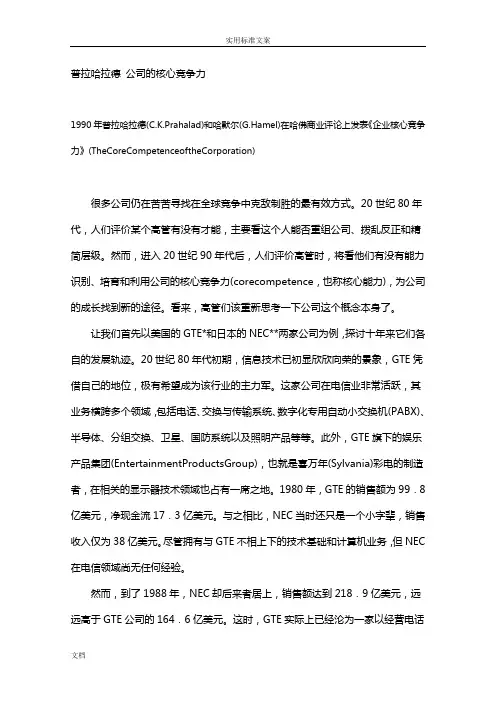
普拉哈拉德公司的核心竞争力1990年普拉哈拉德(C.K.Prahalad)和哈默尔(G.Hamel)在哈佛商业评论上发表《企业核心竞争力》(TheCoreCompetenceoftheCorporation)很多公司仍在苦苦寻找在全球竞争中克敌制胜的最有效方式。
20世纪80年代,人们评价某个高管有没有才能,主要看这个人能否重组公司、拨乱反正和精简层级。
然而,进入20世纪90年代后,人们评价高管时,将看他们有没有能力识别、培育和利用公司的核心竞争力(corecompetence,也称核心能力),为公司的成长找到新的途径。
看来,高管们该重新思考一下公司这个概念本身了。
让我们首先以美国的GTE*和日本的NEC**两家公司为例,探讨十年来它们各自的发展轨迹。
20世纪80年代初期,信息技术已初显欣欣向荣的景象,GTE凭借自己的地位,极有希望成为该行业的主力军。
这家公司在电信业非常活跃,其业务横跨多个领域,包括电话、交换与传输系统、数字化专用自动小交换机(PABX)、半导体、分组交换、卫星、国防系统以及照明产品等等。
此外,GTE旗下的娱乐产品集团(EntertainmentProductsGroup),也就是喜万年(Sylvania)彩电的制造者,在相关的显示器技术领域也占有一席之地。
1980年,GTE的销售额为99.8亿美元,净现金流17.3亿美元。
与之相比,NEC当时还只是一个小字辈,销售收入仅为38亿美元。
尽管拥有与GTE不相上下的技术基础和计算机业务,但NEC 在电信领域尚无任何经验。
然而,到了1988年,NEC却后来者居上,销售额达到218.9亿美元,远远高于GTE公司的164.6亿美元。
这时,GTE实际上已经沦为一家以经营电话业务为主的公司,尽管它在国防和照明产品方面仍占有一席之地。
这家公司的其他业务从全球的角度看已经变得很小。
在过去的几年中,GTE公司已经把喜万年电视机和Telenet业务剥离了出去,把交换机、传输设备和数字PABX等产品转交给合资公司生产,而半导体业务则已关张大吉。
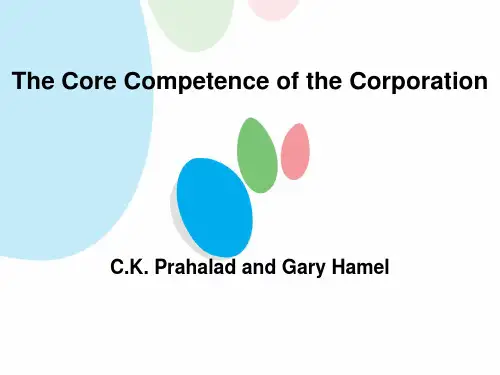
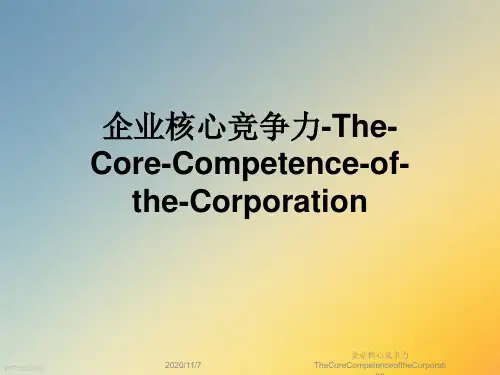

普拉哈拉德公司的核心竞争力1990年普拉哈拉德(C.K.Prahalad)和哈默尔(G.Hamel)在哈佛商业评论上发表《企业核心竞争力》(TheCoreCompetenceoftheCorporation)ﻫ很多公司仍在苦苦寻找在全球竞争中克敌制胜的最有效方式。
20世纪80年代,人们评价某个高管有没有才能,主要看这个人能否重组公司、拨乱反正和精简层级。
然而,进入20世纪90年代后,人们评价高管时,将看他们有没有能力识别、培育和利用公司的核心竞争力(corecompetence,也称核心能力),为公司的成长找到新的途径。
看来,高管们该重新思考一下公司这个概念本身了。
ﻫ让我们首先以美国的GTE*和日本的NEC**两家公司为例,探讨十年来它们各自的发展轨迹。
20世纪80年代初期,信息技术已初显欣欣向荣的景象,GTE凭借自己的地位,极有希望成为该行业的主力军。
这家公司在电信业非常活跃,其业务横跨多个领域,包括电话、交换与传输系统、数字化专用自动小交换机(PABX)、半导体、分组交换、卫星、国防系统以及照明产品等等。
此外,GTE旗下的娱乐产品集团(EntertainmentProductsGroup),也就是喜万年(Sylvania)彩电的制造者,在相关的显示器技术领域也占有一席之地。
1980年,GTE的销售额为99.8亿美元,净现金流17.3亿美元。
与之相比,NEC当时还只是一个小字辈,销售收入仅为38亿美元。
尽管拥有与GTE不相上下的技术基础和计算机业务,但NEC在电信领域尚无任何经验。
ﻫ然而,到了1988年,NEC却后来者居上,销售额达到218.9亿美元,远远高于GTE公司的164.6亿美元。
这时,GTE实际上已经沦为一家以经营电话业务为主的公司,尽管它在国防和照明产品方面仍占有一席之地。
这家公司的其他业务从全球的角度看已经变得很小。
在过去的几年中,GT E公司已经把喜万年电视机和Telenet业务剥离了出去,把交换机、传输设备和数字PABX等产品转交给合资公司生产,而半导体业务则已关张大吉。
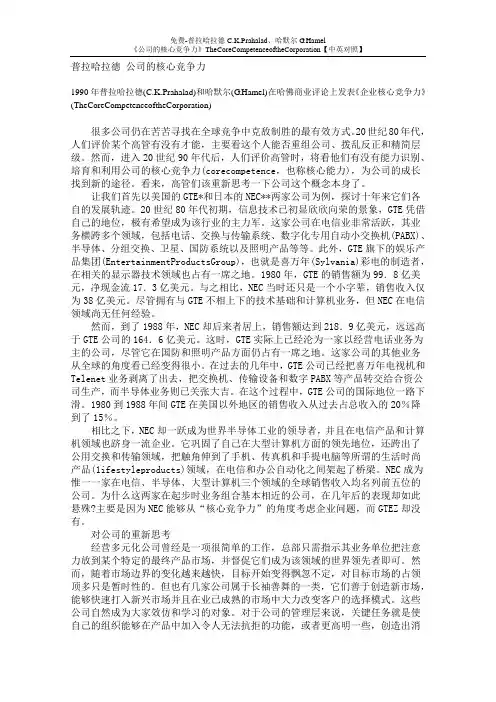
普拉哈拉德公司的核心竞争力1990年普拉哈拉德(C.K.Prahalad)和哈默尔(G.Hamel)在哈佛商业评论上发表《企业核心竞争力》(TheCoreCompetenceoftheCorporation)很多公司仍在苦苦寻找在全球竞争中克敌制胜的最有效方式。
20世纪80年代,人们评价某个高管有没有才能,主要看这个人能否重组公司、拨乱反正和精简层级。
然而,进入20世纪90年代后,人们评价高管时,将看他们有没有能力识别、培育和利用公司的核心竞争力(corecompetence,也称核心能力),为公司的成长找到新的途径。
看来,高管们该重新思考一下公司这个概念本身了。
让我们首先以美国的GTE*和日本的NEC**两家公司为例,探讨十年来它们各自的发展轨迹。
20世纪80年代初期,信息技术已初显欣欣向荣的景象,GTE凭借自己的地位,极有希望成为该行业的主力军。
这家公司在电信业非常活跃,其业务横跨多个领域,包括电话、交换与传输系统、数字化专用自动小交换机(PABX)、半导体、分组交换、卫星、国防系统以及照明产品等等。
此外,GTE旗下的娱乐产品集团(EntertainmentProductsGroup),也就是喜万年(Sylvania)彩电的制造者,在相关的显示器技术领域也占有一席之地。
1980年,GTE的销售额为99.8亿美元,净现金流17.3亿美元。
与之相比,NEC当时还只是一个小字辈,销售收入仅为38亿美元。
尽管拥有与GTE不相上下的技术基础和计算机业务,但NEC在电信领域尚无任何经验。
然而,到了1988年,NEC却后来者居上,销售额达到218.9亿美元,远远高于GTE公司的164.6亿美元。
这时,GTE实际上已经沦为一家以经营电话业务为主的公司,尽管它在国防和照明产品方面仍占有一席之地。
这家公司的其他业务从全球的角度看已经变得很小。
在过去的几年中,GTE公司已经把喜万年电视机和Telenet业务剥离了出去,把交换机、传输设备和数字PABX等产品转交给合资公司生产,而半导体业务则已关张大吉。
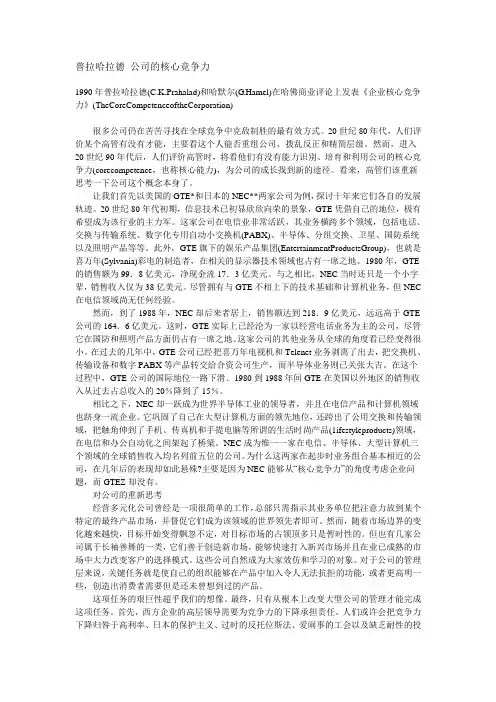
普拉哈拉德公司的核心竞争力1990年普拉哈拉德(C.K.Prahalad)和哈默尔(G.Hamel)在哈佛商业评论上发表《企业核心竞争力》(TheCoreCompetenceoftheCorporation)很多公司仍在苦苦寻找在全球竞争中克敌制胜的最有效方式。
20世纪80年代,人们评价某个高管有没有才能,主要看这个人能否重组公司、拨乱反正和精简层级。
然而,进入20世纪90年代后,人们评价高管时,将看他们有没有能力识别、培育和利用公司的核心竞争力(corecompetence,也称核心能力),为公司的成长找到新的途径。
看来,高管们该重新思考一下公司这个概念本身了。
让我们首先以美国的GTE*和日本的NEC**两家公司为例,探讨十年来它们各自的发展轨迹。
20世纪80年代初期,信息技术已初显欣欣向荣的景象,GTE凭借自己的地位,极有希望成为该行业的主力军。
这家公司在电信业非常活跃,其业务横跨多个领域,包括电话、交换与传输系统、数字化专用自动小交换机(PABX)、半导体、分组交换、卫星、国防系统以及照明产品等等。
此外,GTE旗下的娱乐产品集团(EntertainmentProductsGroup),也就是喜万年(Sylvania)彩电的制造者,在相关的显示器技术领域也占有一席之地。
1980年,GTE 的销售额为99.8亿美元,净现金流17.3亿美元。
与之相比,NEC当时还只是一个小字辈,销售收入仅为38亿美元。
尽管拥有与GTE不相上下的技术基础和计算机业务,但NEC 在电信领域尚无任何经验。
然而,到了1988年,NEC却后来者居上,销售额达到218.9亿美元,远远高于GTE 公司的164.6亿美元。
这时,GTE实际上已经沦为一家以经营电话业务为主的公司,尽管它在国防和照明产品方面仍占有一席之地。
这家公司的其他业务从全球的角度看已经变得很小。
在过去的几年中,GTE公司已经把喜万年电视机和Telenet业务剥离了出去,把交换机、传输设备和数字PABX等产品转交给合资公司生产,而半导体业务则已关张大吉。
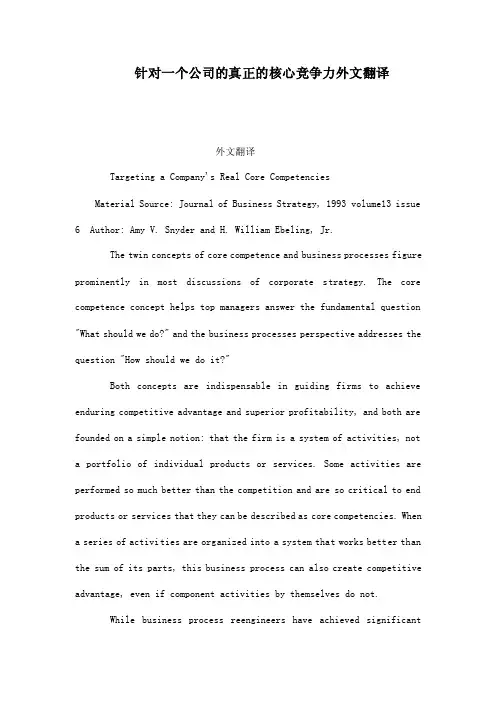
针对一个公司的真正的核心竞争力外文翻译外文翻译Targeting a Company's Real Core CompetenciesMaterial Source: Journal of Business Strategy, 1993 volume13 issue 6 Author: Amy V. Snyder and H. William Ebeling, Jr.The twin concepts of core competence and business processes figure prominently in most discussions of corporate strategy. The core competence concept helps top managers answer the fundamental question "What should we do?" and the business processes perspective addresses the question "How should we do it?"Both concepts are indispensable in guiding firms to achieve enduring competitive advantage and superior profitability, and both are founded on a simple notion: that the firm is a system of activities, not a portfolio of individual products or services. Some activities are performed so much better than the competition and are so critical to end products or services that they can be described as core competencies. When a series of activities are organized into a system that works better than the sum of its parts, this business process can also create competitive advantage, even if component activities by themselves do not.While business process reengineers have achieved significantsuccess in decreasing costs while simultaneously improving service levels, relatively few firms claim to have correctly identified and fully exploited their core competencies or key activities. Throughout this article, we will use the terms core competency and key activity interchangeably. Business process reengineers have developed an analytically rigorous discipline that can be systematically applied and plainly communicated to others. For the core competency concept to achieve this same success, it must be linked to the underlying business economics that drive competitive advantage, and it must be applied in the same systematic manner as the business process concept.In the mid-1970s, corporate planners began to question whether the product-centered business unit was the most appropriate unit of strategic analysis. In work undertaken for a global chemical company in 1977, Braxton Associates redefined the unit of analysis from product-centered business units to activities and developed insights about how competitive advantage is created in the long run.In the course of our work with the chemical company, we demonstrated that gaining a strong relative share in key value-added activities is more relevant to competitive position than gaining share of the related product market. In the 1970s, we used the slicing knife schematic to demonstrate that assessing competitive advantage from a product perspective can lead to erroneous conclusions. The insight thatunderlies the activity perspective is that a firm can not be viewed only as a collection of individual products or services this merely describes the revenue-generating side of the firm. Equally important, the firm is a system of activities that must be organized and managed to imize the value of its offerings while minimizing their cost that is, to create competitive advantage.The slicing knife example makes an important point, but a key question remains. Once it is determined that a firm enjoys a comparatively strong activity position, the next logical question is "So what?" Achieving strong activity position is critical to competitiveness only when the particular activity adds significant value to the end product or service.In the 1980s, Michael Porter documented the concept of the value chain and used it to show how a series of activities could be viewed as a system designed to create competitive advantagePorter's work was instrumental in popularizing the activity perspective and the importance of activity linkages However, the popular version of Porter's value chain does not consider the value-added concept in sufficient depth. This is unfortunate,because the value-added structure determines which activities are critical to success and which are not.It is usually a mistake to invest heavily in activities that represent only a small fraction of the overall value of a firm's productsor services. The company that produced the page you are now reading would be better off with a competency in printing and page setup than in packaging, even though the printed journal was delivered in a protective package, because packaging does not represent a significant fraction of the overall value of the delivered journal.FOUR IMPERATIVES OF CORE COMPETENCIESThe GE and Honda examples demonstrate the importance of organizing around "real" core competencies or activities and the implications of failing to do so. Once senior management develops the strategic intent to identify, nurture, and organize around activities that can be made unique and enduring, a few rules must be followed to transform this commitment into competitive success.Rule 1: Avoid laundry listsIf senior management settles on more than a handful of key activities or core competencies, it is probably over-reaching and certainly ignoring the intent of the word core. Many successful companies have targeted either one or two key activities Identifying key activities is one of the most important contributions senior management can make. In our view, proposed core competencies should: Contribute significantly to the ultimate value of the end product or service.Represent a unique capability that provides enduring competitiveadvantage Have the potential to support multiple end products or services Rule 2: Achieve senior management consensus on core competencies What business are you really in?Evaluating potential core competencies using the previously described screening approach is a necessary but insufficient step in building a competency driven organization. If competencies are to be nurtured and shared widely throughout the firm, senior management must reach consensus on which these are and act on the results of their selection process In working to build senior management consensus on key activities, we have achieved good results using the following approaches among others:Activity-based benchmarking.Employee and asset distribution."What if" scenario development.Activity-based benchmarking is a technique that can steer debate away from subjective opinions and toward hard facts. For example, if the vice president of operations claims that order processing and fulfillment is a core competency, he could develop a persuasive argument by demonstrating an enduring competitive advantage in order processing speed, cost, and customer satisfaction.A compelling argument can also be built by answering some simple questions about an organization's internal configuration, for example:"What do your employees do? Where are your assets?" If 80% of a company's employees are on the plant floor, the marketing vice-president must argue persuasively to convince his colleagues that marketing and sales is really a key activity. After all, people embody the collective learning so extolled today, and learning becomes a formidable competitive weapon when it is built up and shared among a large number of employees "What if" approaches are also useful in working with a group to select core competencies. A senior management deadlock can often be broken by working out the implications of selecting a single core competency as a guide for future actions.In a deadlocked situation, one might ask "What actions are implied by the adoption of core competency 'X'? What products and markets are most attractive given this core competency? What will the company look like five years from now if competency 'X' guides our actions?"These same questions should be answered for each proposed core competency. While this approach may seem simplistic, it can be combined with other, more analytical approaches to help the group reach consensus on a core competency or two that makes the most sense for the corporation.Rule 3: Leverage core competencies inside the organizationOnce senior management identifies and agrees on the firm's core competencies, it must work zealously to ensure that competencies are continually strengthened, shared widely throughout the corporation, andmanaged in a way that best preserves the competitive advantages they create. The importance of this mandate cannot be stressed enough-if senior management fails to organize around key activities, they will disappear.Recall the slicing knife example: while the electric motor manufacturing activity enjoys a strong relative activity share, motor costs will not necessarily be lower than that of the competition. Only if this company organizes and conducts its operations so as to capture the collective learning taking place in the motor manufacturing activity will it drive costs down as cumulative experience increases.Actions that may be necessary to best exploit identified competencies run the spectrum from physically reconfiguring disparate manufacturing processes to simply communicating more effectively. Consider the case of a leading international manufacturer of electrical products. Division A developed expertise in the design and manufacture of surface-mounted printed circuit boards and used this skill to reduce the costs of its products. Division B had an outmoded, expensive production process, in part because it was several generations behind in printed circuit-board design. Division B could have benefitted from Division A's surface-mount expertise and in return could have driven down costs for both divisions by increasing overall volume. Instead, Division A jealously guarded its capabilities, and Division B continued to struggle.This behavior cannot be tolerated if key corporate skills are to be exploited to their fullest potential. New approaches to project coordination and interdepartmental communication can help to break down the barriers. Today, corporate planners are applauding "adaptive organizations," which retain some vestiges of the old hierarchy and maybe a few traditional departments [But rely on] a pattern of constantly changing teams, task forces, partnerships, and other informal structures.The goal of the adaptive organization is to ensure that the best core competencies, whether embodied in technologies, processes, or employees, are linked to the most promising market opportunities so that learning is imized and travels quickly throughout the corporation.Rule 4: Share core competencies outside the corporation as well Sometimes sharing and nurturing core competencies within a corporation is not enough. As markets evolve, new activities may be required. Moreover, in today's global marketplace, even giant corporations blanch at the cost of launching new products and entering new markets. With product lifecycles shrinking and R&D costs skyrocketing, some companies find it easier to embrace their competitors rather than fight them.Collins and Doorley have studied multinational alliance behavior and observe that "The corporation of the future will need to take a more dynamic view of its business. There is often insufficient time to switchfrom one mode of operation to another as markets evolve [through their product lifecycles]. From the very start of a new business, companies must find ways of building competence in each area of competitive advantage even if they are not well placed to do so on their own."Thinking about alliances from the perspective of key activities that can be shared adds clarity to a complex and difficult partner identification process. As senior executives have begun to focus on imizing the value of the core competencies they identify, alliance activity has increased substantially.REDEFINING CORE COMPETENCIESIdentifying core competencies and inspiring the organization to nurture and organize around them is one of the most important contributions senior management can make. The reverse is also true: selecting the wrong competency or too many core competencies is one of the worst conceivable management errors.It is our experience that an effort like this should be undertaken every three to five years, as part of a periodic review of corporate strategy. However, when an industry undergoes a fundamental change in its value-added structure, a reassessment is critical. Often management cannot respond fast enough and heavy losses result Western Union could not make the transition into the information age because it failed to recognize the growing importance of the transmission infrastructure; iteventually fell into bankruptcy. However, when the core check printing business of Deluxe Check Printers became threatened by electronic funds transfer EFT, Deluxe correctly perceived that it had to cultivate new skills to preserve its historical performance. Senior management redefined its core competency from printing checks to facilitating financial transactions and built a successful EFT and data processing business.In redefining its business, Deluxe recognized that its role in check clearing and processing and its financial institution marketing expertise might offer more enduring value to its customers than printing checks. Deluxe combined these enduring skills with acquired skills in computer automation, and it moved successfully in a new direction.Companies with a widely shared understanding of their unique and enduring capabilities and the evolving value-added structure of their industries will rise above the competition, just as Deluxe and Honda did. By whatever name activities, core competencies, or value-chain elements, firms that define their competitive advantage based on structural superiority in the discrete activities they perform are more often than not long-term winners; these companies turn their core competencies into competitive weapons, not competitive traps.译文针对一个公司的真正的核心竞争力资料来源: Journal of Business Strategy(商业策略期刊),1993 volume13 issue 6作者:Amy V. Snyder and H. William Ebeling, Jr.核心竞争力和业务流程的这两个双胞胎概念在多数关于公司策略的讨论中被突出地计算。
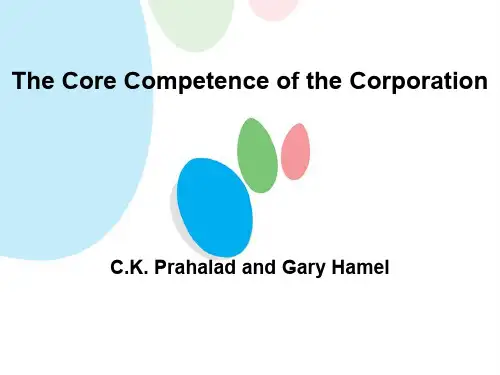
The Core Competence of the CorporationC.K. Prahalad and Gary HamelThe most powerful way to prevail in global competition is still invisible to many companies. During the 1980s, top executives were judged on their ability to restructure, declutter, and delayer their corporations. In the 1990s, they'll be judged on their ability to identify, cultivate, and exploit the core competencies that make growth possible indeed, they'll have to rethink the concept of the corporation itself. Consider the last ten years of GTE and NEC. In the early 1980s, GTE was well positioned to become a major player in the evolving information technology industry. It was active in telecommunications. Its operations spanned a variety of businesses including telephones, switching and transmission systems, digital PABX, semiconductors, packet switching, satellites, defense systems, and lighting products. And GTE's Entertainment Products Group, which produced Sylvania color TVs, had a position in related display technologies. In 1980, GTE's sales were $9.98 billion, and net cash flow was $1.73 billion. NEC, in contrast, was much smaller, at $3.8 billion in sales. It had a comparable technological base and computer businesses, but it had no experience as an operating telecommunications company.Yet look at the positions of GTE and NEC in 1988. GTE's 1988 sales were $16.46 billion, and NEC’s sales were considerably higher at $21.89 billion. GTE has, in effect, become a telephone operating company with a position in defense and lighting products. GTE's other businesses are small in global terms. GTE has divested Sylvania TV and Telenet, put switching, transmission, and digital PABX into joint ventures, and closed down semiconductors. As a result, the international position of GTE has eroded. Non U.S. revenue as a percent of total revenue dropped from 20% to 15% between 1980 and 1988.NEC has emerged as the world leader in semiconductors and as a first tier player in telecommunications products and computers. It has consolidated its positio n in mainframe computers. It has moved beyond public switching and transmission to include such lifestyle products as mobile telephones, facsimile machines, and laptop computers bridging the gap between telecommunications and office automation. NECis the only company in the world to be in the top five in revenue in telecommunications, semiconductors, and mainframes. Why did these two companies, starting with comparable business portfolios, perform so differently? Largely because NEC conceived of itself in terms of "core competencies," and GTE did not. Rethinking the CorporationOnce, the diversified corporation could simply point its business units at particular end product markets and admonish them to become world leaders. But with market boundaries changing ever more quickly, targets are elusive and capture is at best temporary. A few companies have proven themselves adept at inventing new markets, quickly entering emerging markets, and dramatically shifting patterns of customer choice in established markets. These are the ones to emulate. The critical task for management is to create an organization capable of infusing products with irresistible functionality or, better yet, creating products that customers need but have not yet even imagined.This is a deceptively difficult task. Ultimately, it requires radical change in the management of major companies. It means, first of all, that top managements of Western companies must assume responsibility for competitive decline. Everyone knows about high interest rates, Japanese protectionism, outdated antitrust laws, obstreperous unions, and impatient investors. What is harder to see, or harder to acknowledge, is how little added momentum companies actually get from political or macroeconomic "relief." Both the theory and practice of Western management have created a drag on our forward motion. It is the principles of management that are in need of reform.NEC versus GTE, again, is instructive and only one of many such comparative cases we analyzed to understand the changing basis for global leadership. Early in the 1970s, NEC articulated a strategic intent to exploit the convergence of computing and communications, what it called "C&C" Success, top management reckoned, would hinge on acquiring competencies, particularly in semiconductors. Management adopted an appropriate "strategic architecture," summarized by C&C, and then communicated its intent to the whole organization and the outside world during the mid 1970s.NEC constituted a "C&C Committee" of top managers to oversee the development of core products and core competencies. NEC put in place coordination groups and committees that cut across the interests of individual businesses. Consistent with its strategic architecture, NEC shifted enormous resources to strengthen its position in components and central processors. By using collaborative arrangements to multiply internal resources, NEC was able to accumulate a broad array of core competencies. NEC carefully identified three interrelated streams of technological and market evolution. Top management determined that computing would evolve from large mainframes to distributed processing, components from simple ICs to VLSI, and communications from mechanical cross bar exchange to complex digital systems we now call ISDN. As things evolved further, NEC reasoned, the computing, communications, and components businesses would so overlap that it would be very hard to distinguish among them, and that there would be enormous opportunities for any company that had built the competencies needed to serve all three markets.NEC top management determined that semiconductors would be the company's most important "core product." It entered into myriad strategic alliances over 100 as of 1987 aimed at building competencies rapidly and at low cost. In mainframe computers, its most noted relationship was with Honeywell and Bull. Almost all the collaborative arrangements in the semiconductor component field were oriented toward technology access. As they entered collabor ative arrangements, NEC’s operating managers understood the rationale for these alliances and the goal of internalizing partner skills. NEC's director of research summed up its competence acquisition during the 1970s and 1980s this way: "From an investment standpoint, it was much quicker and cheaper to use foreign technology. There wasn't a need for us to develop new ideas.”No such clarity of strategic intent and strategic architecture appeared to exist at GTE. Although senior executives discussed the implications of the evolving information technology industry, no commonly accepted view of which competencies would be required to compete in that industry were communicated widely. While significant staff work was done to identify key technologies, senior line managers continued to act as if they were managing independent business units.Decentralization made it difficult to focus on core competencies. Instead, individual businesses became increasingly dependent on outsiders for critical skills, and collaboration became a route to staged exits. Today, with a new management team in place, GTE has repositioned itself to apply its competencies to emerging markets in telecommunications services.The Roots of Competitive AdvantageThe distinction we observed in the way NEC and GTE conceived of themselves a portfolio of competencies versus a portfolio of businesses was repeated across many industries. From 1980 to 1988, Canon grew by 264%, Honda by 200%. Compare that with Xerox and Chrysler. And if Western managers were once anxious about the low cost and high quality of Japanese imports, they are now over;whelmed by the pace at which Japanese rivals are inventing new markets, creating new products, and enhancing them. Canon has given us personal copiers; Honda has moved from motorcycles to four wheel off road buggies. Sony developed the 8mm camcorder, Yamaha, the digital piano. Komatsu developed an underwater remote controlled bulldozer, while Casio's latest gambit is a small screen color LCD television. Who would have anticipated the evolution of these vanguard markets?In more established markets, the Japanese challenge has been just as disquieting. Japanese companies are generating a blizzard of features and functional enhancements that bring technological sophistication to everyday products. Japanese car producers have been pioneering four wheel steering, four valve-per cylinder engines, in car navigation systems, and sophisticated electronic engine management systems. On the strength of its product features, Canon is now a player in facsimile transmission machines, desktop laser printers, even semiconductor manufacturing equipment.In the short run, a company's competitiveness derives from the price/performance attributes of current products. But the survivors of the first wave of global competition, Western and Japanese alike, are all converging on similar and formidable standards for product cost and quality minimum hurdles for continued competition, but less and less important as sources of differential advantage. In the long run, competitiveness derives from an ability to build, at lower cost and more speedily than competitors, the core competencies that spawn unanticipated products. The real sources of advantageare to be found in management's ability to consolidate corporatewide technologies and production skills into competencies that empower individual businesses to adapt quickly to changing opportunities.Senior executives who claim that they cannot build core competencies either because they feel the autonomy of business units is sacrosanct or because their feet are held to the quarterly budget fire should think again. The problem in many Western companies is not that their senior executives are any less capable than those in Japan nor that Japanese companies possess greater technical capabilities. Instead, it is their adherence to a concept of the corporation that unnecessarily limits the ability of individual businesses to fully exploit the deep reservoir of technological capability that many American and European companies possess.The diversified corporation is a large tree. The trunk and major limbs are core products, the smaller branches are business units; the leaves, flowers, and fruit are end products. The root system that provides nourishment, sustenance, and stability is the core competence. You can miss the strength of competitors by looking only at their end products, in the same way you miss the strength of a tree if you look only at its leaves. (See the chart "Competencies: The Roots of Competitiveness.”)Core competencies are the collective learning in the organization, especially how to coordinate diverse production skills and integrate multiple streams of technologies. Consider Sony's capacity to miniaturize or Philips's optical media expertise. The theoretical knowledge to put a radio on a chip does not in itself assure a company the skill to produce a miniature radio no bigger than a business card. To bring off this feat, Casio must harmonize know how in miniaturization, microprocessor design, material science, and ultrathin precision casing the same skills it applies in its miniature card calculators, pocket TVs, and digital watches.If core competence is about harmonizing streams of technology, it is also about the organization of work and the delivery of value. Among Sony's competencies is miniaturization. To bring miniaturization to its products, Sony must ensure that technologists, engineers, and marketers have a shared understanding of customer needs and of technological possibilities. The force of core competence is felt as decisively in services as in manufacturing. Citicorp was ahead of others investing inan operating system that allowed it to participate in world markets 24 hours a day. Its competence in provided the company the means to differentiate itself from many financial service institutions.Core competence is communication, involvement, and a deep commitment to working across organizational boundaries. It involves many levels of people and all functions. World class research in, for example, lasers or ceramics can take place in corporate laboratories without having an impact on any of the businesses of the company. The skills that together constitute core competence must coalesce around individuals whose efforts are not so narrowly focused that they cannot recognize the opportunities for blending their functional expertise with those of others in new and interesting ways.Core competence does not diminish with use. Unlike physical assets, which do deteriorate over time, competencies are enhanced as they are applied and shared. But competencies still need to be nurtured and protected; knowledge fades if it is not used. Competencies are the glue that binds existing businesses. They are also the engine for new business development. Patterns of diversification and market entry may be guided by them, not just by the attractiveness of markets.Consider 3M's competence with sticky tape. in dreaming up businesses as diverse as "Post it" notes, magnetic tape, photographic film, pressure sensitive tapes, and coated abrasives, the company has brought to bear widely shared competencies in substrates, coatings, and adhesives and devised various ways to combine them. Indeed, 3M has invested consistently in them. What seems to be an extremely diversified portfolio of businesses belies a few shared core competencies.In contrast, there are major companies that have had the potential to build core competencies but failed to do so because top management was unable to conceive of the company as anything other than a collection of discrete businesses. GE sold much of its consumer electronics business to Thomson of France, arguing that it was becoming increasingly difficult to maintain its competitiveness in this sector. That was undoubtedly so, but it is ironic that it sold several key businesses to competitors who were already competence leaders Black & Decker in small electrical motors, and Thomson, which was eager to build its competence in microelectronics and hadlearned from the Japanese that a position in consumer electronics was vital to this challenge.Management trapped in the strategic business unit (SBU) mind set almost inevitably finds its individual businesses dependent on external sources for critical components, such as motors or compressors. But these are not just components. They are core products that contribute to the competitiveness of a wide range of end products. They are the physical embodiments of core competencies.How Not to Think of CompetenceSince companies are in a race to build the competencies that determine global leadership, successful companies have stopped imagining themselves as bundles of businesses making products. Canon, Honda, Casio, or NEC may seem to preside over portfolios of businesses unrelated in terms of customers, distribution channels, and merchandising strategy. Indeed, they have portfolios that may seem idiosyncratic at times: NEC is the only global company to be among leaders in computing, telecommunications, and semiconductors and to have a thriving consumer electronics business.But looks are deceiving. In NEC, digital technology, especially VLSI and systems integration skills, is fundamental. In the core competencies underlying them, disparate businesses become coherent. It is Honda's core competence in engines and power trains that gives it a distinctive advantage in car, motorcycle, lawn mower, and generator businesses. Canon's core competencies in optics, imaging, and microprocessor controls have enabled it to enter, even dominate, markets as seemingly diverse as copiers, laser printers, cameras, and image scanners. Philips worked for more than 15 years to perfect its optical media (laser disc) competence, as did JVC in building a leading position in video recording. Other examples of core competencies might include mechantronics (the ability to marry mechanical and electronic engineering), video displays, bioengineering, and microelectronics. In the early stages of its competence building, Philips could not have imagined all the products that would be spawned by its optical media competence, nor could JVC have anticipated miniature camcorders when it first began exploring videotape technologies.Unlike the battle for global brand dominance, which is visible in the world's bro adcast and print media and is aimed at building global "share of mind,” the battle to build world class competencies is invisible to people who aren't deliberately looking for it. Top management often tracks the cost and quality of competitors' products, yet how many managers untangle the web of alliances their Japanese competitors have constructed to acquire competencies at low cost? In how many Western boardrooms is there an explicit, shared understanding of the competencies the company must build for world leadership? Indeed, how many senior executives discuss the crucial distinction between competitive strategy at the level of a business and competitive strategy at the level of an entire company?Let us be clear. Cultivating core competence does not mean outspending rivals on research and development. In 1983, when Canon surpassed Xerox in worldwide unit market share in the copier business, its R&D budget in reprographics was but a small fraction of Xerox's. Over the past 20 years, NEC has spent less on R&D as a percentage of sales than almost all of its American and European competitors.Nor does core competence mean shared costs, as when two or more SBUs use a common facility a plant, service facility, or sales force or share a common component. The gains of sharing may be substantial, but the search for shared costs is typically a post hoc effort to rationalize production across existing businesses, not a premeditated effort to build the competencies out of which the businesses themselves grow. Building core competencies is more ambitious and different than integrating vertically, moreover. Managers deciding whether to make or buy will start with end products and look upstream to the efficiencies of the supply chain and downstream toward distribution and customers. They do not take inventory of skills and look forward to applying them in nontraditional ways. (Of course, decisions about competencies do provide a logic for vertical integration. Canon is not particularly integrated in its copier business, except in those aspects of the vertical chain that Support the competencies it regards as critical.)Identifying Core Competencies And Losing ThemAt least three tests can be applied to identify core competencies in a company. First, a core competence provides potential access to a wide variety of markets.Competence in display systems, for example, enables a company to participate in such diverse businesses as calculators, miniature TV sets, monitors for laptop computers, and automotive dashboards which is why Casio's entry into the handheld TV market was predictable. Second, a core competence should make a significant contribution to the perceived customer benefits of the end product. Clearly, Honda's engine expertise fills this bill.Finally, a core competence should be difficult for competitors to imitate. And it will be difficult if it is a complex harmonization of individual technologies and production skills. A rival might acquire some of the technologies that comprise the core competence, but it will find it more difficult to duplicate the more or less comprehensive pattern of internal coordination and learning. JVC’s decision in the early 1960s to pursue the development of a videotape competence passed the three tests outlined here. RCA’s decis ion in the late 1970s to develop a stylus based video turntable system did not.Few companies are likely to build world leadership in more than five or six fundamental competencies. A company that compiles a list of 20 to 30 capabilities has probably not produced a list of core competencies. Still, it is probably a good discipline to generate a list of this sort and to see aggregate capabilities as building blocks. This tends to prompt the search for licensing deals and alliances through which the company may acquire, at low cost, the missing pieces.Most Western companies hardly think about competitiveness in these terms at all. It is time to take a tough minded look at the risks they are running. Companies that judge competitiveness, their own and their competitors', primarily in terms of the price/performance of end products are courting the erosion of core competencies – or making too little effort to enhance them. The embedded skills that give rise to the next generation of competitive products cannot be "rented in" by outsourcing and OEM-supply relationships. In our view, too many companies have unwittingly surrendered core competencies when they cut internal investment in what they mistakenly thought were just "cost centers" in favor of outside suppliers.Consider Chrysler. Unlike Honda, it has tended to view engines and power trains as simply one more component. Chrysler is becoming increasingly dependent onMitsubishi and Hyundai: between 1985 and 1987, the number of outsourced engines went from 252,000 to 382,000. It is difficult to imagine Honda yielding manufacturing responsibility, much less design, of so critical a part of a car's function to an outside company which is why Honda has made such an enormous commitment to Formula One auto racing. Honda has been able to pool its engine related technologies; it has parlayed these into a corporate wide competency from which it develops world beating products, despite R&D budgets smaller than those of GM and Toyota.Of course, it is perfectly possible for a company to have a competitive product line up but be a laggard in developing core competencies at least for a while. If a company wanted to enter the copier business today, it would find a dozen Japanese companies more than willing to supply copiers on the basis of an OEM private label. But when fundamental technologies changed or if its supplier decided to enter the market directly and become a competitor, that company's product line, along with all of its investments in marketing and distribution, could be vulnerable. Outsourcing can provide a shortcut to a more competitive product, but it typically contributes little to building the people embodied skills that are needed to sustain product leadership.Nor is it possible for a company to have an intelligent alliance or sourcing strategy if it has not made a choice about where it will build competence leadership. Clearly, Japanese companies have benefited from alliances. They've used them to learn from Western partners who were not fully committed to preserving core competencies of their own. As we've argued in these pages before, learning within an alliance takes a positive commitment of resources- travel, a pool of dedicated people, test bed facilities, time to internalize and test what has been learned. A company may not make this effort if it doesn't have clear goals for competence building.Another way of losing is forgoing opportunities to establish competencies that are evolving in existing businesses. In the 1970s and 1980s, many American and European companies like GE, Motorola, GTE, Thom, and GEC chose to exit the color television business, which they regarded as mature. If by "mature" they meant that they had run out of new product ideas at precisely the moment global rivals had targeted the TV business for entry, then yes, the industry was mature. But it certainlywasn't mature in the sense that all opportunities to enhance and apply video based competencies had been exhausted.In ridding themselves of their television businesses, these companies failed to distinguish between divesting the business and destroying their video media based competencies. They not only got out of the TV business but they also closed the door on a whole stream of future opportunities reliant on video based competencies. The television industry, considered by many U.S. companies in the 1970s to be unattractive, is today the focus of a fierce public policy debate about the inability of U.S. corporations to benefit from the $20 billion a year opportunity that HDTV will represent in the mid to late 1990s. Ironically, the U.S. government is being asked to fund a massive research project in effect, to compensate U.S. companies for their failure to preserve critical core competencies when they had the chance.In contrast, one can see a company like Sony reducing its emphasis on VCRs (where it has not been very successful and where Korean companies now threaten), without reducing its commitment to video related competencies. Sony's Betamax led to a debacle. But it emerged with its videotape recording competencies intact and is currently challenging Matsushita in the 8mm camcorder market.There are two clear lessons here. First, the costs of losing a core competence can be only partly calculated in advance. The baby may be thrown out with the bath water in divestment decisions. Second, since core competencies are built through a process of continuous improvement and enhancement that may span a decade or longer, a company that has failed to invest in core competence building will find it very difficult to, enter an emerging market, unless, of course, it will be content simply to serve as a distribution channel.American semiconductor companies like Motorola learned this painful lesson when they elected to forgo direct participation in the 256k generation of DRAM chips. Having skipped this round, Motorola, like most of its American competitors, needed a large infusion of technical help from Japanese partners to rejoin the battle in the 1 megabyte generation. When it comes to core competencies, it is difficult to get off the train, walk to the next station, and then reboard.From Core Competencies to Core Products.The tangible link between identified core competencies and end products is what we call the core products- the physical embodiments of one or more core competencies. Honda's engines, for example, are core products, linchpins between design and development skills that ultimately lead to a proliferation of end products. Core products are the components or subassemblies that actually contribute to the value of the end products. Thinking in terms of core products forces a company to distinguish between the brand share it achieves in end product markets (for example, 40% of the U.S. refrigerator market) and the manufacturing share it achieves in any particular core product (for example, 5% of the world share of compressor output). Canon is reputed to have an 84% world manufacturing share in desktop laser printer "engines," even though its brand share in the laser printer business is minuscule. Similarly, Matsushita has a world manufacturing share of about 45% in key VCR components, far in excess of its brandshare (Panasonic, JVC, and others) of 20%. And Matsushita has a commanding core product share in compressors worldwide, estimated at 40%, even though its brand share in both the air conditioning and refrigerator businesses is quite small.It is essential to make this distinction between core competencies, core products, and end products because global competition is played out by different rules and for different stakes at each level. To build or defend leadership over the long term, a corporation will probably be a winner at each level. At the level of core competence, the goal is to build world leadership in the design and development of a particular class of product functionality be it compact data storage and retrieval, as with Philips's optical media competence, or compactness and ease of use, as with Sony's micromotors and microprocessor controls.To sustain leadership in their chosen core competence areas, these companies seek to maximize their world manufacturing share in core products. The manufacture of core products for a wide variety of external (and internal) customers yields the revenue and market feedback that, at least partly, determines the pace at which core competencies can be enhanced and extended. This thinking was behind JVC's decision in the mid 1970s to establish VCR supply relationships with leading national consumer electronics companies in Europe and the United States. In supplying。
本科毕业论文(设计)外文翻译题目会计师事务所核心竞争力探究专业会计学外文题目The Core Competence of the Corporation 外文出处Harvard Business Review May-June 1990 外文作者普拉哈拉德原文:The Core Competence of the CorporationThe most powerful way to prevail in global competition is still invisible to many companies. During the 1980s, top executives were judged on their ability to restructure, declutter, and delayer their corporations. In the 1990s, they'll be judged on their ability to identify, cultivate, and exploit the core competencies that make growth possible indeed, they'll have to rethink the concept of the corporation itself.Consider the last ten years of GTE and NEC. In the early 1980s, GTE was well positioned to become a major player in the evolving information technology industry. It was active in telecommunications. Its operations spanned a variety of businesses including telephones, switching and transmission systems, digital PABX, semiconductors, packet switching, satellites, defense systems, and lighting products. And GTE's Entertainment Products Group, which produced Sylvania color TVs, had a position in related display technologies. In 1980, GTE's sales were $9.98 billion, and net cash flow was $1.73 billion. NEC, in contrast, was much smaller, at $3.8 billion in sales. It had a comparable technological base and computer businesses, but it had no experience as an operating telecommunications company.Yet look at the positions of GTE and NEC in 1988. GTE's 1988 sales were $16.46 billion, and NEC’s sales were considerably higher at $21.89 billion. GTE has, in effect, become a telephone operating company with a position in defense and lighting products. GTE's other businesses are small in global terms. GTE has divested Sylvania TV and Telenet, put switching, transmission, and digital PABX into joint ventures, and closed down semiconductors. As a result, the international position of GTE has eroded. Non U.S. revenue as a percent of total revenue dropped from 20% to 15% between 1980 and 1988.NEC has emerged as the world leader in semiconductors and as a first tier player in telecommunications products and computers. It has consolidated its position in mainframe computers. It has moved beyond public switching and transmission to include such lifestyle products as mobile telephones, facsimile machines, and laptopcomputers bridging the gap between telecommunications and office automation. NEC is the only company in the world to be in the top five in revenue in telecommunications, semiconductors, and mainframes. Why did these two companies, starting with comparable business portfolios, perform so differently? Largely because NEC conceived of itself in terms of "core competencies," and GTE did not. Rethinking the CorporationOnce, the diversified corporation could simply point its business units at particular end product markets and admonish them to become world leaders. But with market boundaries changing ever more quickly, targets are elusive and capture is at best temporary. A few companies have proven themselves adept at inventing new markets, quickly entering emerging markets, and dramatically shifting patterns of customer choice in established markets. These are the ones to emulate. The critical task for management is to create an organization capable of infusing products with irresistible functionality or, better yet, creating products that customers need but have not yet even imagined)This is a deceptively difficult task. Ultimately, it requires radical change in the management of major companies. It means, first of all, that top managements of Western companies must assume responsibility for competitive decline. Everyone knows about high interest rates, Japanese protectionism, outdated antitrust laws, obstreperous unions, and impatient investors. What is harder to see, or harder to acknowledge, is how little added momentum companies actually get from political or macroeconomic "relief." Both the theory and practice of Western management have created a drag on our forward motion. It is the principles of management that are in need of reform.NEC versus GTE, again, is instructive and only one of many such comparative cases we analyzed to understand the changing basis for global leadership. Early in the 1970s, NEC articulated a strategic intent to exploit the convergence of computing and communications, what it called "C&C" Success, top management reckoned, would hinge on acquiring competencies, particularly in semiconductors. Management adopted an appropriate "strategic architecture," summarized by C&C, and thencommunicated its intent to the whole organization and the outside world during the mid 1970s.NEC constituted a "C&C Committee" of top managers to oversee the development of core products and core competencies. NEC put in place coordination groups and committees that cut across the interests of individual businesses. Consistent with its strategic architecture, NEC shifted enormous resources to strengthen its position in components and central processors. By using collaborative arrangements to multiply internal resources, NEC was able to accumulate a broad array of core competencies.NEC carefully identified three interrelated streams of technological and market evolution. Top management determined that computing would evolve from large mainframes to distributed processing, components from simple ICs to VLSI, and communications from mechanical cross bar exchange to complex digital systems we now call ISDN. As things evolved further, NEC reasoned, the computing, communications, and components businesses would so overlap that it would be very hard to distinguish among them, and that there would be enormous opportunities for any company that had built the competencies needed to serve all three markets.NEC top management determined that semiconductors would be the company's most important "core product." It entered into myriad strategic alliances over 100 as of 1987 aimed at building competencies rapidly and at low cost. In mainframe computers, its most noted relationship was with Honeywell and Bull. Almost all the collaborative arrangements in the semiconductor component field were oriented toward technology access. As they entered collaborative arrangements, NEC’s operating managers understood the rationale for these alliances and the goal of internalizing partner skills. NEC's director of research summed up its competence acquisition during the 1970s and 1980s this way: "From an investment standpoint, it was much quicker and cheaper to use foreign technology. There wasn't a need for us to develop new ideas.”No such clarity of strategic intent and strategic architecture appeared to exist at GTE. Although senior executives discussed the implications of the evolvinginformation technology industry, no commonly accepted view of which competencies would be required to compete in that industry were communicated widely. While significant staff work was done to identify key technologies, senior line managers continued to act as if they were managing independent business units. Decentralization made it difficult to focus on core competencies. Instead, individual businesses became increasingly dependent on outsiders for critical skills, and collaboration became a route to staged exits. Today, with a new management team in place, GTE has repositioned itself to apply its competencies to emerging markets in telecommunications services.The Roots of Competitive AdvantageThe distinction we observed in the way NEC and GTE conceived of themselves a portfolio of competencies versus a portfolio of businesses was repeated across many industries. From 1980 to 1988, Canon grew by 264%, Honda by 200%. Compare that with Xerox and Chrysler. And if Western managers were once anxious about the low cost and high quality of Japanese imports, they are now over;whelmed by the pace at which Japanese rivals are inventing new markets, creating new products, and enhancing them. Canon has given us personal copiers; Honda has moved from motorcycles to four wheel off road buggies. Sony developed the 8mm camcorder, Yamaha, the digital piano. Komatsu developed an underwater remote controlled bulldozer, while Casio's latest gambit is a small screen color LCD television. Who would have anticipated the evolution of these vanguard markets?In more established markets, the Japanese challenge has been just as disquieting. Japanese companies are generating a blizzard of features and functional enhancements that bring technological sophistication to everyday products. Japanese car producers have been pioneering four wheel steering, four valve-per cylinder engines, in car navigation systems, and sophisticated electronic engine management systems. On the strength of its product features, Canon is now a player in facsimile transmission machines, desktop laser printers, even semiconductor manufacturing equipment.In the short run, a company's competitiveness derives from the price/performance attributes of current products. But the survivors of the first wave ofglobal competition, Western and Japanese alike, are all converging on similar and formidable standards for product cost and quality minimum hurdles for continued competition, but less and less important as sources of differential advantage. In the long run, competitiveness derives from an ability to build, at lower cost and more speedily than competitors, the core competencies that spawn unanticipated products. The real sources of advantage are to be found in management's ability to consolidate corporatewide technologies and production skills into competencies that empower individual businesses to adapt quickly to changing opportunities.Senior executives who claim that they cannot build core competencies either because they feel the autonomy of business units is sacrosanct or because their feet are held to the quarterly budget fire should think again. The problem in many Western companies is not that their senior executives are any less capable than those in Japan nor that Japanese companies possess greater technical capabilities. Instead, it is their adherence to a concept of the corporation that unnecessarily limits the ability of individual businesses to fully exploit the deep reservoir of technological capability that many American and European companies possess.The diversified corporation is a large tree. The trunk and major limbs are core products, the smaller branches are business units; the leaves, flowers, and fruit are end products. The root system that provides nourishment, sustenance, and stability is the core competence. You can miss the strength of competitors by looking only at their end products, in the same way you miss the strength of a tree if you look only at its leaves. (See the chart "Competencies: T he Roots of Competitiveness.”) Core competencies are the collective learning in the organization, especially how to coordinate diverse production skills and integrate multiple streams of technologies. Consider Sony's capacity to miniaturize or Philips's optical media expertise. The theoretical knowledge to put a radio on a chip does not in itself assure a company the skill to produce a miniature radio no bigger than a business card. To bring off this feat, Casio must harmonize know how in miniaturization, microprocessor design, material science, and ultrathin precision casing the same skills it applies in its miniature card calculators, pocket TVs, and digital watches.If core competence is about harmonizing streams of technology, it is also about the organization of work and the delivery of value. Among Sony's competencies is miniaturization. To bring miniaturization to its products, Sony must ensure that technologists, engineers, and marketers have a shared understanding of customer needs and of technological possibilities. The force of core competence is felt as decisively in services as in manufacturing. Citicorp was ahead of others investing in an operating system that allowed it to participate in world markets 24 hours a day. Its competence in provided the company the means to differentiate itself from many financial service institutions.Core competence is communication, involvement, and a deep commitment to working across organizational boundaries. It involves many levels of people and all functions. World class research in, for example, lasers or ceramics can take place in corporate laboratories without having an impact on any of the businesses of the company. The skills that together constitute core competence must coalesce around individuals whose efforts are not so narrowly focused that they cannot recognize the opportunities for blending their functional expertise with those of others in new and interesting ways.Core competence does not diminish with use. Unlike physical assets, which do deteriorate over time, competencies are enhanced as they are applied and shared. But competencies still need to be nurtured and protected; knowledge fades if it is not used. Competencies are the glue that binds existing businesses. They are also the engine for new business development. Patterns of diversification and market entry may be guided by them, not just by the attractiveness of markets.Consider 3M's competence with sticky tape. in dreaming up businesses as diverse as "Post it" notes, magnetic tape, photographic film, pressure sensitive tapes, and coated abrasives, the company has brought to bear widely shared competencies in substrates, coatings, and adhesives and devised various ways to combine them. Indeed, 3M has invested consistently in them. What seems to be an extremely diversified portfolio of businesses belies a few shared core competencies.In contrast, there are major companies that have had the potential to build corecompetencies but failed to do so because top management was unable to conceive of the company as anything other than a collection of discrete businesses. GE sold much of its consumer electronics business to Thomson of France, arguing that it was becoming increasingly difficult to maintain its competitiveness in this sector. That was undoubtedly so, but it is ironic that it sold several key businesses to competitors who were already competence leaders Black & Decker in small electrical motors, and Thomson, which was eager to build its competence in microelectronics and had learned from the Japanese that a position in consumer electronics was vital to this challenge.Management trapped in the strategic business unit (SBU) mind set almost inevitably finds its individual businesses dependent on external sources for critical components, such as motors or compressors. But these are not just components. They are core products that contribute to the competitiveness of a wide range of end products. They are the physical embodiments of core competencies.Source:Harved Business Review May-June 1990译文:公司的核心竞争力很多公司仍在苦苦寻找在全球竞争中克敌制胜的最有效方式。